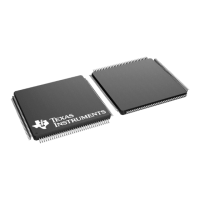Usage Notes and Known Design Exceptions to Functional Specifications
www.ti.com
38
SPRZ412K–December 2013–Revised February 2020
Submit Documentation Feedback
Copyright © 2013–2020, Texas Instruments Incorporated
TMS320F2837xD Dual-Core MCUs Silicon Revisions C, B, A, 0
Advisory CMPSS: COMPxLATCH May Not Clear Properly Under Certain Conditions
Revision(s) Affected 0, A, B, C
Details The CMPSS latched path is designed to retain a tripped state within a local latch
(COMPxLATCH) until it is cleared by software (via COMPSTSCLR) or by PWMSYNC.
COMPxLATCH is set indirectly by the comparator output after the signal has been
digitized and qualified by the Digital Filter. The maximum latency expected for the
comparator output to reach COMPxLATCH may be expressed in CMPSS module clock
cycles as:
LATENCY = 1 + (1 x FILTER_PRESCALE) + (FILTER_THRESH x FILTER_PRESCALE)
When COMPxLATCH is cleared by software or by PWMSYNC, the latch itself is cleared
as desired, but the data path prior to COMPxLATCH may not reflect the comparator
output value for an additional LATENCY number of module clock cycles. If the Digital
Filter output resolves to a logical 1 when COMPxLATCH is cleared, the latch will be set
again on the following clock cycle.
Workaround(s) Allow the Digital Filter output to resolve to logical 0 before clearing COMPxLATCH.
If COMPxLATCH is cleared by software, the output state of the Digital Filter can be
confirmed through the COMPSTS register prior to clearing the latch. For instances
where a large LATENCY value produces intolerable delays, the filter FIFO may be
flushed by reinitializing the Digital Filter (via CTRIPxFILCTL).
If COMPxLATCH is cleared by PWMSYNC, the user application should be designed
such that the comparator trip condition is cleared at least LATENCY cycles before
PWMSYNC is generated.
Advisory CMPSS: Ramp Generator May Not Start Under Certain Conditions
Revision(s) Affected 0, A, B, C
Details The Ramp Generator is designed to produce a falling-ramp DAC reference that is
synchronized with a PWMSYNC signal. Upon receiving a PMWSYNC signal, the Ramp
Generator will start to decrement its DAC value. When COMPSTS[COMPHSTS] is
asserted by a trip event, the Ramp Generator will stop decrementing its DAC value.
If COMPSTS[COMPHSTS] is asserted simultaneously with a PWMSYNC signal, the
desired behavior is for the PWMSYNC signal to take priority such that the Ramp
Generator starts to decrement in the new EPWM cycle. Instead of the desired behavior,
the COMPSTS[COMPHSTS] trip condition will take priority over PWMSYNC such that
the Ramp Generator stops decrementing for a full EPWM cycle until the next
PWMSYNC signal is detected.
Workaround(s) Avoid COMPSTS[COMPHSTS] trip conditions when PWMSYNC is generated. For
example, peak current mode control applications can limit the PWM duty cycle to a
maximum value that will avoid simultaneous COMPSTS[COMPHSTS] and PWMSYNC
assertions.
Advisory CMPSS: CMPIN4N, CMPIN4P, CMPIN5N, and CMPIN5P Not Available
Revision(s) Affected 0, A
Details The CMPIN4N, CMPIN4P, CMPIN5N, and CMPIN5P functions are not available on the
silicon revisions affected.
Workaround(s) None
